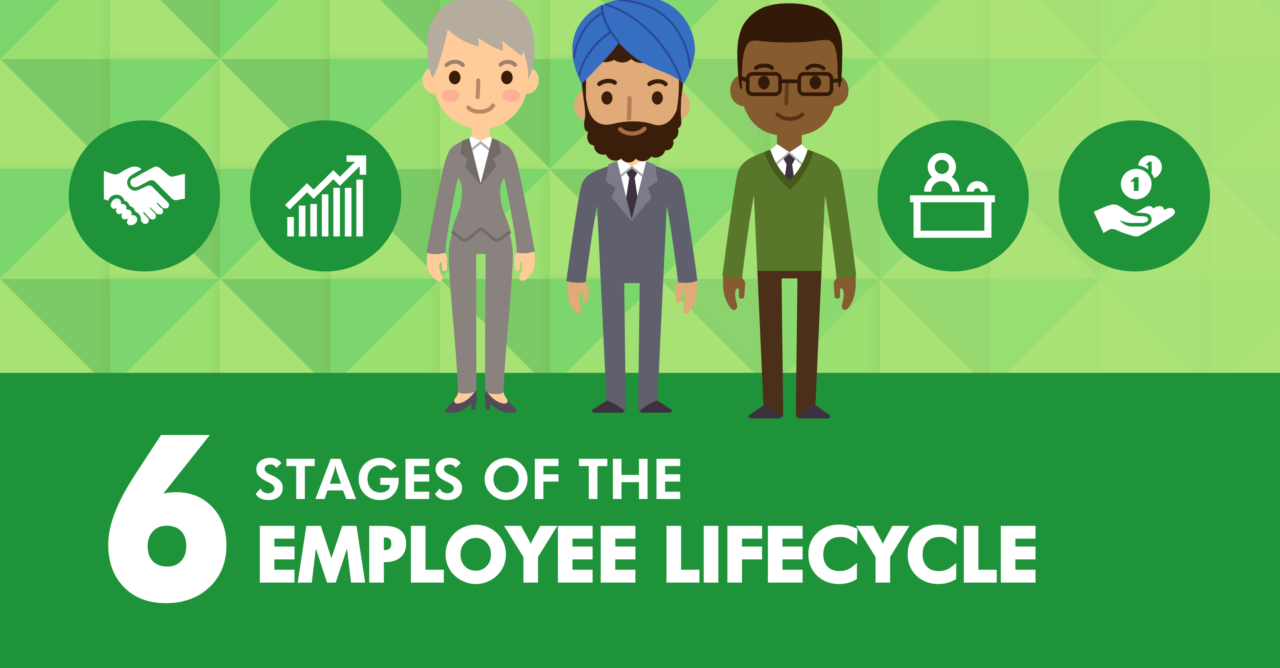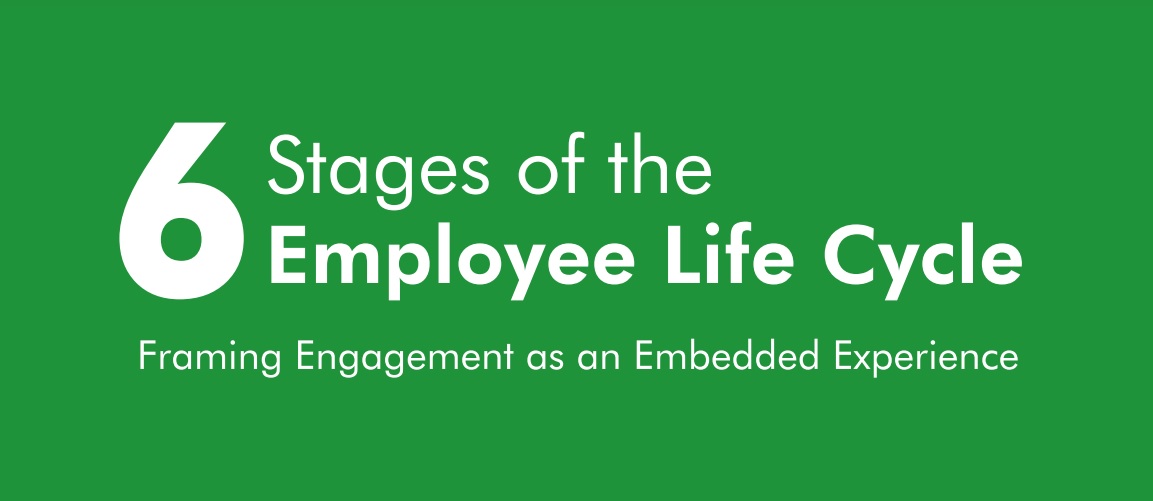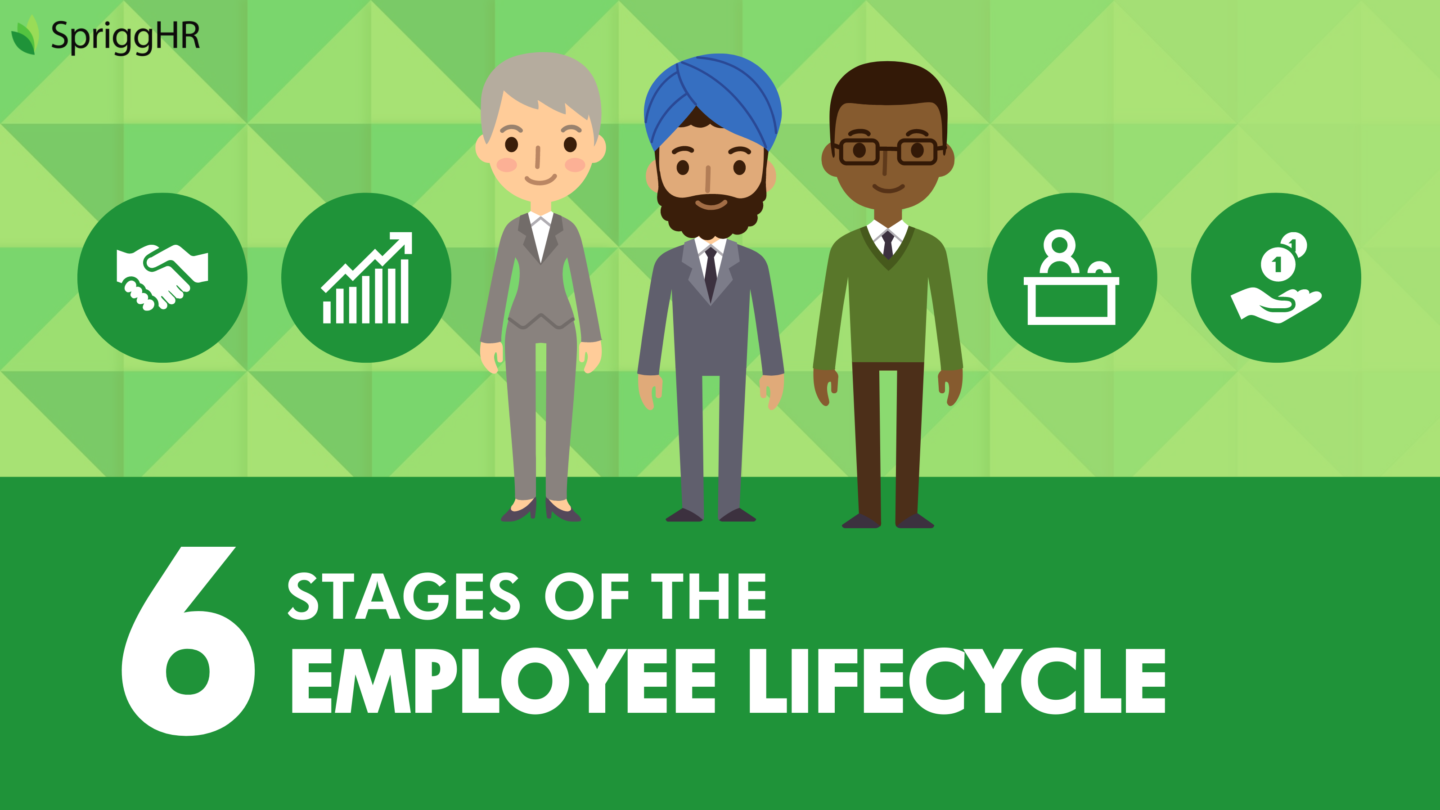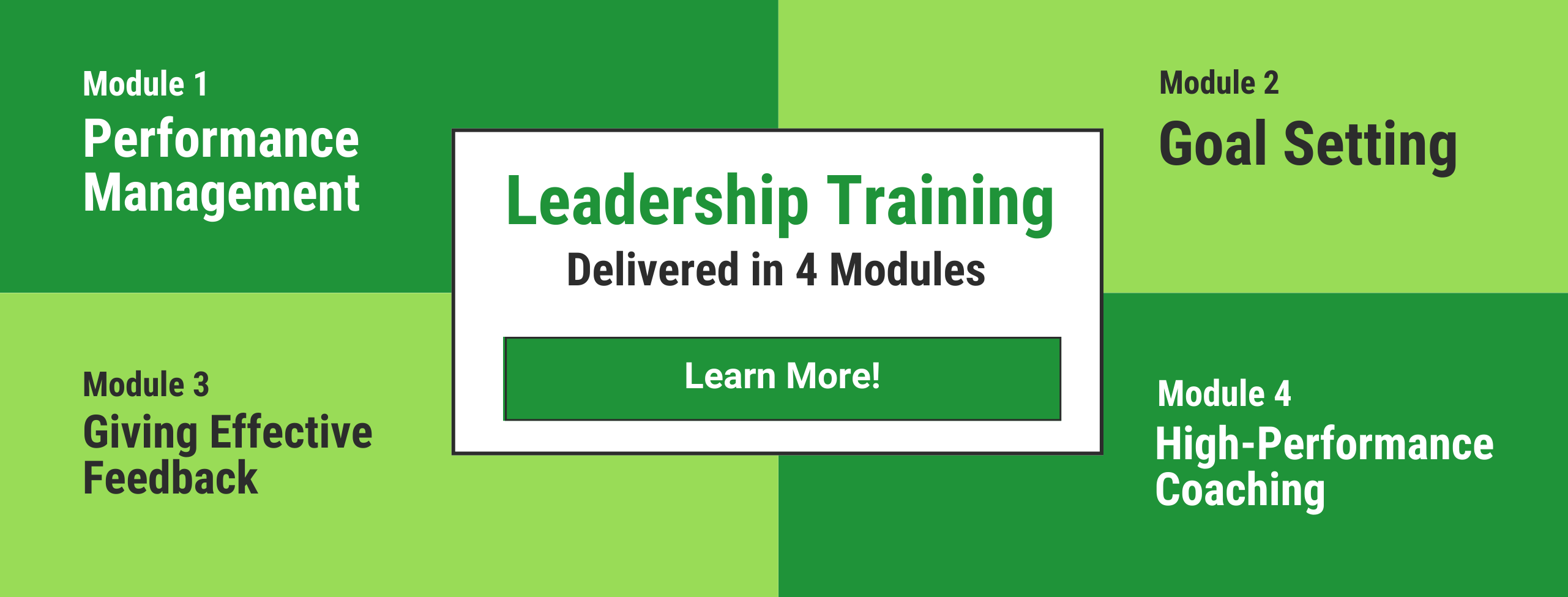
The 6 Stages of the Employee Life Cycle
Designing and encouraging an employee experience that leads to longevity, success, and great employee engagement should be a permanent mindset within your company. Rather than looking at employee engagement efforts as one-time endeavors when morale is low, the employee life cycle model frames engagement as a designed experience embedded into the trajectory of every employee within your organization.
What is the Employee Life Cycle Model?
The employee life cycle model (ELC) is an organizational method used to visualize how an employee engages with the company they are a part of. There are six stages involved in this model: Attraction, Recruitment, Onboarding, Development, Retention, and Separation.
The employee life cycle model is geared to encompass every stage of an employee’s experience within a company, formatting that trajectory into a framework that provides a different engagement strategy for each stage the employee enters. For example, if a company has an excellent and engaging recruitment strategy, but high turnover rates, they can focus on the retention stage in their ELC in order to develop a suitable solution for the issue.
The employee life cycle model greatly resembles the typical customer journey, which is intentional! Essentially, designing an employee life cycle strategy is rooted in the idea that the employee experience is just as valuable as their customer’s experience. Many large organizations don’t have a true idea of the value of employee engagement, choosing instead to focus on customer satisfaction and viewing employee engagement efforts as temporary programs rather than a consistent corporate mindset. In order for your company to be able to capitalize on your workforce’s talent, you need to be able to turn engagement data into meaningful intelligence at all managerial levels, helping your employees recognize their contributions to the company and driving engagement and success.
The Advantages of Implementing an Employee Life Cycle Strategy
By mapping out the employee journey in the same way you map out the customer experience, your company will see two main benefits: better talent retention, and reputation improvement. The ability to effectively allocate resources and efforts to reduce turnover issues reduces the time and money that turnover costs cause for the company. Similarly, a better reputation increases the chances of hiring more new talent, meaning a more committed and driven workforce.
In a hurry? Take the infographic to go!

Employee Life Cycle
Send download link to:
The 6 Employee Life Cycle Stages
In order to understand exactly how each stage of the employee life cycle can drive employee engagement, let’s examine each stage in greater detail.
1. Attraction
The first stage of the employee life cycle is the employee attraction stage. Regardless of how innovative and strong your product or service is, without the attraction and retention of great talent, your company will fail. This makes the attraction stage one of the most crucial aspects to any organization’s growth strategy.
The attraction stage is the only stage that occurs before you have an open position in the company. Also referred to as the employer brand, it is the projection of the image of your organization as a great place to work, both in the minds of current employees as well as key stakeholders in the external market. This means that active and passive talent candidates, clients, customers, and potential stakeholders have a positive perspective of how it is to work within your company.
In order to build a great employer brand and succeed in the employee attraction stage, there are several key tips you can follow:
- Raise Brand awareness. Have your managers attend seminars and conferences regularly, seek out speaking opportunities, and be a regular contributor or sponsor of popular industry magazines, websites, and blogs. This will help build up your profile within the industry as a great place to work.
- Be known to have a great culture. Regardless of external marketing tactics, the employee remains the most valuable and convincing promoter for any company. By having a fantastic company culture, you only increase the chances that your existing employees will regularly tell others about how great it is to work within your organization. You can also amplify these efforts by sharing insights into your culture publicly using company social media accounts.
- Offer attractive benefits and compensation. Being competitive with compensation is one of the most obvious efforts your company can make to appeal to the top talent in your industry. This does not mean you need to pay the most to attract the best, but you should never pay the least. Seek out opportunities to provide softer benefits in addition to your existing ones, such as team lunches, birthdays off, and so on.
2. Recruitment
The second stage of the employee life cycle is the employee recruitment stage, the period where you seek out and recruit the best talent to join your organization. Recruitment can occur as a result of an existing role becoming vacant, or a new position being created altogether. The best types of recruitment plans offer an optimal candidate experience, support collaborative hiring centered around clear criteria and processes, and provide meaningful data that can be used to improve hiring results over time.
In order to succeed in recruiting the right talent for your team, here are several key tips to include in your recruitment stage:
- Ask for referrals from your existing team. Perhaps one of the best recruitment strategies out there is a referral from one of your own employees. As active members of the industry, they likely know several people who could be a perfect fit for the role you are trying to fill. However, be careful not to hire close friends or family of existing team members, as this can make the dynamic more challenging. Typically, these referrals will share a similar value set also.
- Try out various recruitment platforms. Sticking to only one major recruitment website or media severely limits your candidate pool. Ask yourself where it is that your ideal candidates frequent their visits. This could be an industry meetup, or a lesser-known but growing industry magazine that many new potential industry leaders are subscribed to.
- Be specific in who and what you are looking for. A sure-fire way to limit the chances of recruiting the most suitable candidates for a role is to publish vague employment advertisements. While being broad can be useful in casting a wider net, you should still be careful to outline all the pre-requisites to save you and the candidate’s time in applying and assessing.
- Involve your employees. In addition to encouraging them to refer potential candidates, you can also ask your existing employees to help determine the best requirements for the role. Your team members can even assist you in reviewing the resumes and qualifications of potential candidates, if you see appropriate. Another useful way you can involve your employees is to request that someone in a very similar role joins in on the interview process, in order to assess the candidates that best fit within the team.
3. Onboarding
The next stage of the employee life cycle model is the employee onboarding stage. Occurring after you have recruited the top talent, the onboarding period is critical to getting your new hires well-adjusted to the organizational environment and performance aspects of their new job as quickly and smoothly as possible. During the onboarding stage, new employees cover more in-depth aspects of their position, identify the attitudes, knowledge, skills, and behaviors that are required to function effectively within the organization.
Making new hires feel welcomed in the team and well-acclimatized to the nature of both their role and the organization is critical to drawing out long-term contributions and engagement. Here are some key strategies you can employ to ensure that the onboarding stage of your company’s employee life cycle run smoothly for all concerned:
- Have a job description. It does not have to be a long and academic analysis of the demands of the job but aim to have a single page outline that lists the most important duties of the role, as well as any associated experience and skills.
- Discuss the company’s vision and values. Laying out your company values and vision and discussing what they all mean with your new hire is a vital component of any onboarding process. Clarify any questions they may have and get a sense of what the values mean to them, ensuring their perspective aligns with success.
- Outline your expectations clearly. The job description will carry some of the detail, but it is still critical to lead each new hire through the expectations you are asking from them, along with explaining why they are important to company success.
- Do follow-ups regularly. Completing the first week’s induction stage and then leaving the new hire to fend for themselves is bound to result in a rapid decline in employee performance. Schedule face to face meetings with each new employee after a few weeks, checking in on how they are managing, what challenges they may have found integrating with the team, and so on.
4. Development
The following stage of the employee life cycle model is the employee development stage. It is during this period that you begin to consistently encourage professional development amongst your team, which acts as a catalyst in their skill development, and also helps provide them with a future career path within the company.
Some key tips you can follow to improve the professional development stage of your employee life cycle model include:
- Encourage external learning. Providing your team members with opportunities to attend relevant conferences and seminar yields tremendous benefits for their skill development (many are available as virtual offerings online). A good way to do this is to regularly send them at the company cost or offer all employees a company-covered budget for their own initiated event attendance.
- Assess knowledge and skills together. In order to best identify an employee’s key skills and areas of expertise, managers should work with the employee directly. Leveraging their own insight into their performance, you can then plan out and prioritize the areas that require further development. This is also one of the best ways to establish an open, honest feedback-driven relationship between you and your employees.
- Encourage your team members to be responsible for their own development. In order to ensure employees, remain focused, you should encourage them to each develop a professional action plan. This plan should set out to help them develop their abilities and increase their chances of career advancement. You can either collaborate with them on this process or provide a general template to the whole team that they can follow to complete their own simple plan.
- Reward the employees who learn in their own time. Many of your team members likely take part in regular informal development outside of their normal work hours. When you hear of a staff member doing this, make a point of finding out more about it, and sincerely thank them for their efforts and ensure they know they are appreciated.
5. Retention
The fifth stage of the lifecycle model is the employee retention stage. It is here that you focus your energies on keeping your top employees, and ensuring they are happy and sufficiently challenged in their respective roles within the team. The influence of company culture goes a long way in this stage. If the culture in your organization is poor, it inevitably leads to a high employee turnover rate, meaning you will have to face replacement costs regularly. Improving the retention stage is a great way to counteract this risk and promote longevity and satisfaction amongst your team’s career paths.
Some tips to help ensure you are retaining your key people, and improving the employee retention stage of your lifecycle model, include:
- Hire the right people. In order to retain the top talent, you need to first attract and recruit the top talent. This is where the success of your attraction and retention stages can be measured – if you were careful in your process and approach of who you hired to begin with, then you will stand a better chance of keeping the right employees in your team.
- Cultivate great relationships with your team members. Building and fostering an open, honest, and respectful relationship with everyone on your team is critical to keeping them motivated to stay with your company.
- Openly communicate your organizational mission and team aspirations. In order to improve your employee retention rate, you first need to ensure that your team thoroughly understands and is committed to the same mission and direction as the company. You should be regularly communicating with them on where they belong within the company, and how their specific roles and accomplishments help the organization to execute its mission.
- Seek out employee feedback and measure team morale frequently. For smaller companies, a weekly face to face meeting with the team can be useful, where you set out to discuss how the team is progressing and identify any problems or issues they are facing. Another useful tool can be employee pulse surveys. If you want to regularly measure team morale, and seek out constant effective feedback, utilizing shorter employee survey tools or implementing an online feedback mechanism such as Sprigg’s Continuous & 360 Degree Feedback tool can be particularly useful.
- Understand what motivates your employees. No one employee is the exact same, and in turn, no one thing will motivate every single employee to work hard. Understanding what drives and motivates various team members means that you can engage your employees and ideally retain them.
6. Separation
The final stage of the employee life cycle is the employee separation stage. For most employees, there comes a point where their employment lifecycle will reach its conclusion, whether from retirement, new employment, or for personal reasons. Treating the separation process with equal importance as the onboarding process and being equally as strategic in how you approach this stage, is critical. When a team member leaves, it has an effect on other members.
It is the responsibility of the manager and HR professionals within the company to ensure that the employee who is leaving, exits in a way that doesn’t cause major disruption. If you find yourself faced with a situation where a key employee separates from your organization unexpectedly, there are a few key tips you can use to minimize the effects of that disruption:
- Understand the reasoning behind the resignation. What an employee states as their reason for resignation, and what the actual reasons are, are often not the same. Aim to dig deep at what truly caused the separation, so you can avoid the circumstances that led to it in the future.
- Remain positive. You will feel a sense of loss at a top performer leaving your team but it does not mean that you will never find another great employee to replace them.
- Ask for honest feedback. When someone leaves a company, conduct an exit-interview as it is one of the greatest opportunities to glean honest feedback about what it’s truly like to work in the organization.
- Remind the team to keep looking ahead. Oftentimes, the loss of a valued employee can cause a decrease in overall team morale. Aim to concentrate of reaffirming commitment to the remaining team members, reminding them that while their departure is disappointing, the team will ultimately recover and grow as a result of it.
In Summary
The employee life cycle model is one of the best was to visualize and plan for each stage of an employee’s interactions with your company, providing you with the insight necessary to make each stage of their time with your company as successful as possible. By focusing on doing the best you can at each stage, you are much more likely to attract and retain a fantastic team.
Take the infographic to go!
Employee Life Cycle
Send download link to:





